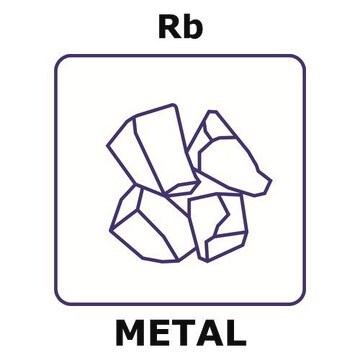276332
Rubidium
ingot, 99.6% trace metals basis
About This Item
Produits recommandés
Pureté
99.6% trace metals basis
Forme
ingot
Pertinence de la réaction
reagent type: reductant
Conditionnement
pkg of Packaged in: Breakseal Ampule
Résistivité
11.0 μΩ-cm, 20°C
Impuretés
0.2-0.4% Cs
Point d'ébullition
686 °C (lit.)
Pf
38-39 °C (lit.)
Densité
1.53 g/mL at 25 °C (lit.)
Chaîne SMILES
[Rb]
InChI
1S/Rb
Clé InChI
IGLNJRXAVVLDKE-UHFFFAOYSA-N
Vous recherchez des produits similaires ? Visite Guide de comparaison des produits
Description générale
Application
It can also be used as a reducing agent to synthesize reduced polycyclic aromatic hydrocarbons.
Mention d'avertissement
Danger
Mentions de danger
Conseils de prudence
Classification des risques
Eye Dam. 1 - Skin Corr. 1B - Water-react 1
Risques supp
Code de la classe de stockage
4.3 - Hazardous materials which set free flammable gases upon contact with water
Classe de danger pour l'eau (WGK)
WGK 3
Point d'éclair (°F)
Not applicable
Point d'éclair (°C)
Not applicable
Équipement de protection individuelle
Eyeshields, Faceshields, Gloves, type P3 (EN 143) respirator cartridges
Certificats d'analyse (COA)
Recherchez un Certificats d'analyse (COA) en saisissant le numéro de lot du produit. Les numéros de lot figurent sur l'étiquette du produit après les mots "Lot" ou "Batch".
Déjà en possession de ce produit ?
Retrouvez la documentation relative aux produits que vous avez récemment achetés dans la Bibliothèque de documents.
Les clients ont également consulté
Notre équipe de scientifiques dispose d'une expérience dans tous les secteurs de la recherche, notamment en sciences de la vie, science des matériaux, synthèse chimique, chromatographie, analyse et dans de nombreux autres domaines..
Contacter notre Service technique












